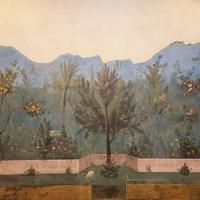More about Jesus in the Garden of Olives

Contributor
A long time ago in a country far away called Spain there lived a successful artist called Doménikos Thetokópoulos.
Today he’s better known as El Greco, or “The Greek”, called so because he lived in and studied art in Greece before moving to Toledo, Spain. El Greco ran a workshop in Toledo and that workshop is where he turned out some of his most famous works, including this work painted between 1600 and 1607.
Jesus in the Garden of Olives or “The Agony in the Garden of Gethsemane” as it is sometimes called, is one of El Greco’s most popular works so, to capitalize on the work’s popularity, he made several versions of the same painting from the late 1580s until the end of his life.
Every version consists of a waifish Jesus hanging out in a spotlight and talking to an angel with a cup; the disciples, John, James the greater, and Peter are all nearby in food comas; and Judas is always in the background, on his way with Roman soldiers to arrest Jesus.
Part of the reason that this work was so popular in its time was the subject matter. It’s all taken from the story of Easter, long before a giant rabbit left eggs and candy around for kids. This particular chapter is from the Last Supper’s after party, when Jesus took John, James, and Peter out to the Mountain of Olives, where the wandered over to the Garden of Gethsemane to pray. The three disciples prayed themselves to sleep, leaving Jesus alone, praying to God that he could save humans from sin without being crucified. In response, an angel came down from Heaven with a cup and, by accepting the cup, Jesus symbolically accepted his fate. People in the 1600s ate that symbolism stuff up.
Sure this work is technically impressive and is sometimes considered a major influence in the development of modern art, but it might not even be the work of the late and great El Greco! It wasn’t even considered part of El Greco’s repertoire until 1928 when a German scholar saw the work in Buenos Aires and included it in his published catalog of El Greco’s work. There is a signature in the corner of the painting with what looks like El Greco’s full name spelled out, but it’s been mostly rubbed off from years of existing and is barely legible. Given the time when this work was painted, though, El Greco may not have touched this piece. His workshop may have done all the work and just copied the subjects from El Greco’s previous versions of the work. Regardless of who painted it, it helped make a hoopla for El Greco in modern times.
Next time you go to a family Easter celebration and dig through the yard for eggs, just remember: it all started with a man in the garden begging for his life. Enjoy!
Sources
- Bayne, Jen. 2012. “Artwork Of The Week: El Greco's Easter Story.” HuffPost UK. HuffPost. June 9. http://www.huffingtonpost.co.uk/2012/04/09/el-greco-agony-in-the-garden….
- “Jesus in the Garden of Olives.” 2017. Jesus in the Garden of Olives / 16th-20th century Paintings / Highlights / Collections - Palais des Beaux Arts de Lille. Caisse D'Erargne. Accessed December 23. http://www.pba-lille.fr/en/Collections/Highlights/16th-
- NSNC, grupo. 2017. “Description: Jesus in the Garden of Olives (Jesús en el Huerto de los Olivos).” Museo Nacional de Bellas Artes. Amigos del Bellas Artes. Accessed December 23. https://www.bellasartes.gob.ar/en/the-collection-highlights/2569.
- “The Agony in the Garden of Gethsemane.” 2017. The National Gallery. The National Gallery. https://www.nationalgallery.org.uk/paintings/studio-of-el-greco-the-ago….












